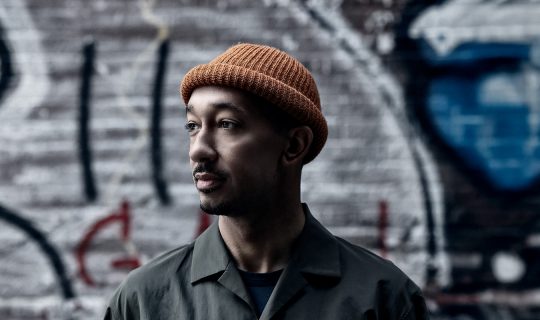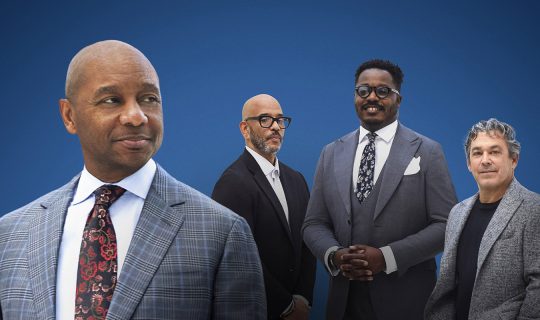December 30, 2012
A Blue Note recording artist since 1991, the grounded but searching tenor saxophonist Joe Lovano released Cross Culture, his 23rd album for the label, this Tuesday, January 8th. Over the phone before a Village Vanguard gig with Sound Prints, the five-piece he co-leads with trumpeter Dave Douglas, we talked to Lovano about some of his key Blue Note recordings from the ’90s.
Landmarks (1991): Lovano’s first album for Blue Note, the sly Landmarks features the leader backed by guitar, piano, bass, and drums, not to mention the production prowess of six-string superman John Scofield. “We worked together very loosely,” explains Lovano about co-producing Landmarks with the guitarist. “John was at the date, and was in the booth with the engineer, and really helped to make sure everything went down the way it was supposed to. That recording was all of my tunes and I had an amazing ensemble, with John Abercrombie on guitar, Kenny Werner on piano, Marc Johnson on bass, and the young Bill Stewart on drums, who shortly after that joined [Scofield’s] quartet.”
One of the standout tracks from Landmarks is Lovano’s “Here and Now,” an aggressive piece marked by Abercrombie’s crunchy guitar and Stewart’s propulsive drumming. “I wrote that tune for the record date and to feature Bill,” says Lovano about “Here and Now.” “That whole piece is a real drum feature. From playing with him, and knowing him, and developing some music together at that period—he was in my groups at that time—I wrote that piece with him in mind and it just took off.”
Tenor Legacy (1993): This album places the two-tenor team of Lovano and Joshua Redman in front of a rhythm section comprised of pianist Mulgrew Miller, bassist Christian McBride, drummer Lewis Nash, and percussionist Don Alias. “I grew up playing with my dad,” says Lovano by way of explanation. “My dad was a strong, forceful tenor saxophonist from Cleveland, Ohio. His name was Tony “Big T” Lovano. And he was one of the leading forces around Cleveland in his time. He grew up in the swing and bebop and modern jazz eras, and embraced the music fully. And I grew up standing toe to toe with him: trying to match his sound, and carry on the feeling in the music that I was getting from him. The two-tenor tradition in jazz is a very strong one. Wardell Gray and Dexter Gordon. Gene Ammons and Sonny Stitt. Dexter Gordon and Gene Ammons. All kinds of combinations through the years have really inspired and been an important part of the music.”
The subtly funky “Blackwell’s Message,” a tribute to the late drummer Ed Blackwell, is one of the highlights of Legacy. “After Landmarks, my next recording was called From the Soul, which had Michel Petrucciani, Dave Holland, and Blackwell,” says Lovano. “And during that period of playing with him, he had some signature rhythms and things that he played, that he loved to play, and it vibrated in his body and the whole room. And there’s a little figure in ‘Blackwell’s Message’ that was one of these figures that Blackwell would always play and it was a springboard for him to play ideas off of. So I used that little figure and created that piece.”
Quartets: Live at the Village Vanguard (1994): Quartets features a pair of foursomes recorded within the magical confines of New York’s Village Vanguard. The first disc, which finds Lovano in the company of trumpeter Tom Harrell, bassist Anthony Cox, and drummer Billy Hart, leans toward free jazz. “It was a real collective exploration of the music,” says Lovano. “And Tom and I, and Anthony and Billy, had played together in many different settings over the 10 years prior to this record. And then I put this particular quartet together, and wrote the music, and had an idea about how we were playing together that was so special. And the sparks and the freeness within the music. So there’s a lot of free approaches within it. I don’t like to say ‘free jazz.’ I like to say ‘jazz-free.’ So we were creating music spontaneously within the forms and structures that are set.”
Built on bouncy drones and ostinatos from Cox and pushing drumming from Hart, the frisky, greasy “Fort Worth” is reminiscent of some of Ornette Coleman’s early pieces. “That’s where Ornette and Dewey Redman were from,” explains Lovano about “Fort Worth.” “I wrote it when I played in Fort Worth, at the Caravan of Dreams with John Scofield. I was in Fort Worth and vibing on all those cats who were from there, and that tune came together at that moment. It was a perfect tune to revisit with the quartet with Tom. That’s one of my few tunes that’s actually featured on a few different recordings.”
Trio Fascination: Edition One (1998): On the first volume of Trio Fascination, the leader is in conversation with two masters of the music: bassist Dave Holland and drummer Elvin Jones. Alone out front, Lovano picks up some unexpected horns to keep things from stagnating. “I played a few different instruments throughout the date,” he recalls. “Like a straight alto, and some soprano saxophone. Tenor, alto clarinet. In a trio, you do have some open spaces, and I explore multiple instruments on the same recording. It changes the color and it keeps the flow moving in a direction that’s really free and spontaneous. So throughout that recording, I might switch horns in the same tune. Play different moments with different attitude on a different instrument. In a trio, I love to do that.”
“Studio Rivbea,” a playful swinger that arrives halfway through the album, is named for the room where Lovano first met Holland. “When I first moved to New York in 1976, Sam Rivers had a loft space that he called Studio Rivbea,” says Lovano. “And I had a chance to go there many times and hear a lot of cats play. Long before I ever met any of them. I heard Anthony Braxton there, and I also heard Sam play with Barry Altschul and Dave. That place was an important music venue in New York during the ’70s. And when I first came to town, it was one of the first places that I gravitated to. I wrote that tune about that place, and about Sam!”
Friendly Fire (1999): Friendly Fire pits Lovano against another strong sax personality, alto adventurer Greg Osby, with pianist Jason Moran, bassist Cameron Brown, and drummer Idris Muhammad as the rhythm section. “Greg wrote three pieces or so,” states Lovano. “And I wrote three pieces. And then we chose a couple classic things. ‘Broad Way Blues’ was one of Ornette Coleman’s tunes that he recorded on Blue Note. He did two records for Blue Note with Elvin and Jimmy Garrison and Dewey Redman [Love Call and New York Is Now], and that was one of the tunes from one of those records. So I thought that would be hip to put that on there and revisit a tune that was on one of Ornette’s Blue Note records.”
Written for Muhammad, of course, the tricky “Idris” is a showcase for the drummer’s smart, groove-heavy playing. “He’s not a stylized player, in a way,” says Lovano of Muhammad. “He’s a funk drummer. He’s a jazz drummer. He’s a free player. He has many elements in his approach. But what really stands out with Idris is his independence. The way he plays the bass drum? Like no other, man. And his snare drum articulation is from a real marching-band root, yet he can translate those rudiments and rhythms into phrases. And he plays with a conception of phrasing and breathing with the soloist that is amazing.”
Check out this Spotify playlist of tunes from Joe Lovano’s 1990s albums.
Photos courtesy of Jimmy Katz




